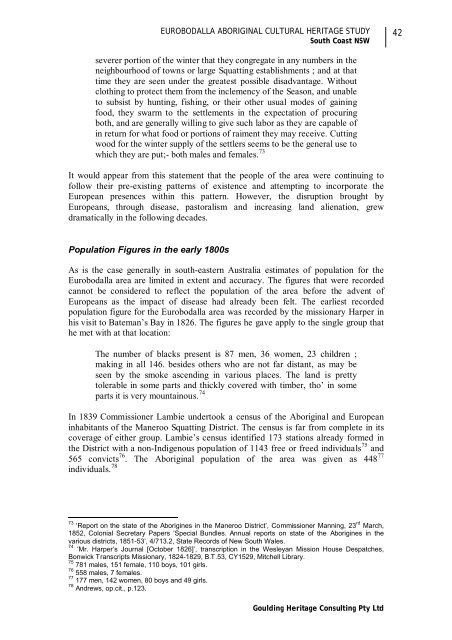Pages 9 - 77 (1600kb) - Eurobodalla Shire Council
Pages 9 - 77 (1600kb) - Eurobodalla Shire Council
Pages 9 - 77 (1600kb) - Eurobodalla Shire Council
You also want an ePaper? Increase the reach of your titles
YUMPU automatically turns print PDFs into web optimized ePapers that Google loves.
EUROBODALLA ABORIGINAL CULTURAL HERITAGE STUDY<br />
South Coast NSW<br />
severer portion of the winter that they congregate in any numbers in the<br />
neighbourhood of towns or large Squatting establishments ; and at that<br />
time they are seen under the greatest possible disadvantage. Without<br />
clothing to protect them from the inclemency of the Season, and unable<br />
to subsist by hunting, fishing, or their other usual modes of gaining<br />
food, they swarm to the settlements in the expectation of procuring<br />
both, and are generally willing to give such labor as they are capable of<br />
in return for what food or portions of raiment they may receive. Cutting<br />
wood for the winter supply of the settlers seems to be the general use to<br />
which they are put;- both males and females. 73<br />
It would appear from this statement that the people of the area were continuing to<br />
follow their pre-existing patterns of existence and attempting to incorporate the<br />
European presences within this pattern. However, the disruption brought by<br />
Europeans, through disease, pastoralism and increasing land alienation, grew<br />
dramatically in the following decades.<br />
Population Figures in the early 1800s<br />
As is the case generally in south-eastern Australia estimates of population for the<br />
<strong>Eurobodalla</strong> area are limited in extent and accuracy. The figures that were recorded<br />
cannot be considered to reflect the population of the area before the advent of<br />
Europeans as the impact of disease had already been felt. The earliest recorded<br />
population figure for the <strong>Eurobodalla</strong> area was recorded by the missionary Harper in<br />
his visit to Bateman’s Bay in 1826. The figures he gave apply to the single group that<br />
he met with at that location:<br />
The number of blacks present is 87 men, 36 women, 23 children ;<br />
making in all 146. besides others who are not far distant, as may be<br />
seen by the smoke ascending in various places. The land is pretty<br />
tolerable in some parts and thickly covered with timber, tho’ in some<br />
parts it is very mountainous. 74<br />
In 1839 Commissioner Lambie undertook a census of the Aboriginal and European<br />
inhabitants of the Maneroo Squatting District. The census is far from complete in its<br />
coverage of either group. Lambie’s census identified 173 stations already formed in<br />
the District with a non-Indigenous population of 1143 free or freed individuals 75 and<br />
565 convicts 76 . The Aboriginal population of the area was given as 448 <strong>77</strong><br />
individuals. 78<br />
73 rd<br />
‘Report on the state of the Aborigines in the Maneroo District’, Commissioner Manning, 23 March,<br />
1852, Colonial Secretary Papers ‘Special Bundles. Annual reports on state of the Aborigines in the<br />
various districts, 1851-53’, 4/713.2, State Records of New South Wales.<br />
74<br />
‘Mr. Harper’s Journal [October 1826]’, transcription in the Wesleyan Mission House Despatches,<br />
Bonwick Transcripts Missionary, 1824-1829, B.T.53, CY1529, Mitchell Library.<br />
75<br />
781 males, 151 female, 110 boys, 101 girls.<br />
76<br />
558 males, 7 females.<br />
<strong>77</strong><br />
1<strong>77</strong> men, 142 women, 80 boys and 49 girls.<br />
78<br />
Andrews, op.cit., p.123.<br />
Goulding Heritage Consulting Pty Ltd<br />
42
















